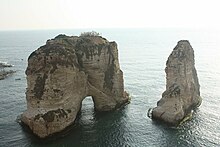|
Saliba (name)
Saliba (Arabic: صليبا), also transliterated "Saleeba", or Salibi (Arabic: الصليبي), also transliterated "Saleeby", is a Christian family name of Arabic origin used in the Levant and Malta. The family name comes from the aramaic (sliba) but also from the Arabic cognate "صليب" (salîb), meaning "cross", a reference to the crucifixion of Jesus Christ.[1] 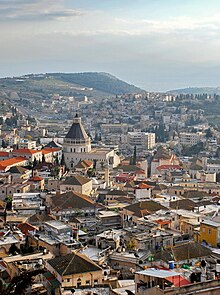 Overview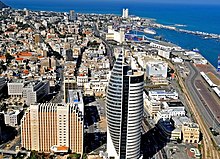 Historically, the Saliba family has been Antiochian Orthodox and of upper-middle and upper classes in their respective countries. Some members of the family converted to Islam and are today Muslim. Since Ottoman times, the majority of Salibas involved themselves in professional, political and cultural professions serving as mediators between their local communities and Muslim overlords. Today, many Salibas are prominent doctors, lawyers, bishops, media personalities, business owners, professors, writers and political activists. Based primarily in smaller towns such as Nazareth, Mandate Palestine and Bteghrine in Mount Lebanon, by the 1930s and 1940s, most families established themselves in cities in what's today Shefa-'Amr, Palestine and Achrafieh, a neighborhood of Beirut. Since the Ottoman persecutions during the 1860 Mount Lebanon civil war, to the 1948 Palestinian expulsion and flight and Lebanese Civil War, various branches of the Saliba family have made their way abroad. Today, just as many Salibas live in the Middle East as those in the United States, Canada, Germany, France, Denmark, Australia, Brazil and various countries in North Africa. Religion Overwhelmingly Antiochian Orthodox, the family has significant numbers of other Christians including those from the Melkite Greek Catholic Church and Syriac Orthodox, Maronite Catholic, Roman Catholic and smaller amounts of Protestant converts. Throughout various Arabic-speaking Christian communities, the surname and members of the family are widely known. The family names Saleeby and Saliba have been in use in Lebanon, Palestine and Syria since at least the 2nd century AD and are speculated by many to be one of the first Christian family names. 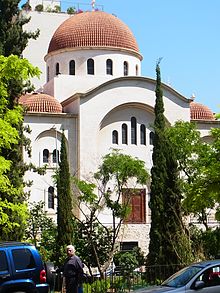 Today, several key archbishops both in the Middle East and in the diaspora have attained significant honors. To varying degrees and through multiple mediums, clergy members of the Saliba family have spoken out against the genocide of Christians by ISIL and other groups such as the Yazidis. Further back in time, the Saliba name and its root "salib" grew in prominence and became a term to identify geographically Christian areas. In Aleppo, the Christian neighborhood of Saliba became famous in the tragic Massacre of Aleppo (1850).[2] In Cairo, Saliba Street (شارع صليبة), a formerly Christian road, is now home to some of the greatest sites in Cairo. In the strategic Syrian city of Latakia, the Saliba neighborhood and square have become important demonstration sites in the Syrian Civil War. In Haifa, Wadi Salib (وادي صليب), or Valley of the Cross, was the site of much controversy, displacement and riot in the early half of the 20th century as Muslim and Christian residents were forcibly removed before and after the establishment of the state of Israel.     Varying historical narrativesWhile there are many overlapping elements in each historical narrative, all three stories of the Saliba clan's settlement in Lebanon, Palestine and Syria embody key differences: Sparta narrativeThe Sparta narrative is by far the most rich and complex tale of Saliba origin. In their family lands above the modern town of Bteghrine, Lebanon, there is an area known as "Sparta", many centuries earlier, the Saliba family named the area as such. The rich folklore that surrounds the area has been traced back thousands of years to before the birth of Jesus Christ to ancient Greece. The folklore composed by N.D. Saleeby, Souk-El-Gharb, Lebanon, 1947 A.D. is as follows:
While the tale is of great richness, the story is often disputed, especially among family members outside Bteghrine who contest its validity. Western neo-Aramaic rootsAnother theory, which is disputed and is without detail is the one of Western neo-Aramaic roots versus Spartan lineage. The general story goes as such: Before the coming of Christ, the Saliba family were an inland Syriac-speaking Semitic people. Found in Palestine and what is today eastern Lebanon and Western Syria, many Syriac-speaking locals became enticed by the Christian message and converted. After the influence of Greek Byzantine traditions in coastal cities, the majority of Christians in these areas joined the Greek Orthodox Patriarch of Antioch. From these times on, families like the Saliba's became administrative and educated under the Greek system. After the coming of Islam, these Greek Orthodox families were easily adaptive and continued their tradition of education and administration under the many Islamic empires.
This theory is criticized because it does not take into consideration the fact that name Saliba was adopted by people of various ethnic origin. The prominence of using variants of Saliba as neighborhood and street names in Islamic cities such as Aleppo, Latakia and Cairo would attest to the great amount of travels prominent Arabic speaking Christians made in the various Islamic eras. What is likely to be the case is that the Saliba family name have mixed roots and various origins as Levantine Muslim and Christians tend to have due to all the intermixing that took place in the Levant between various people for thousands of years. Many also adopted family names based on the name of an area they lived in or come from a family that separated into various clans with each having their own name. The name Saliba or Salibi could also be given to people who lived in the Levant during the time of the crusades. It is incorrect to assume that everyone with the last name belongs to the same family and has the same ethnic origin. Melkite lineageThe last theory is that the Saliba family has their origins in a mix of many groups. The tale goes as this: Before the times of Jesus, the Saliba family and people like them were Aramaic/Syriac and Greek-speaking Jews. The term Hellenistic Judaism describes those at the time who claimed Jewish ancestry, but followed Greek customs and culture. After encountering the Christian faith, many of these people converted. Until the Council of Chalcedon in 451 CE, all Christians of the Levant were united. After, however, more provincial populations and their traditions broke from the patriarchates of Rome and Constantinople. This split resulted in the Syriac Orthodox, Church of the East, Maronite and Armenian Apostolic traditions. For the more urbanized Greek-speaking Christians of the coast, their allegiances remained firmly with Constantinople and more specifically the Greek Orthodox Patriarch of Antioch. As time went on, their religious traditions evolved and resembled more Byzantine practices than those non-Chalcedonian Christians. As time passed and Islam became dominant, Salibas continued to live in urban areas and maintain a close familial network from Antakya to Nazareth and Damascus to Latakia. During persecutions in the 17th and 18th centuries, many Salibas moved to more mountainous communities such as Bteghrine in Mount Lebanon. As the centuries continued, many moved for economic and political benefit to southern Lebanon, the Galilee and surrounding towns around Bteghrine. As modern urbanization grew in the 20th century, Salibas of Mount Lebanon and Galilee emigrated to cities like Beirut and Haifa for prosperity while maintaining their political and economic ties to cities like Bteghrine and Nazareth. After numerous wars and economic instability, members of the family moved to cities across the world. Maltese usageThe Saliba/Salibi Maltese familial connection is still disputed. While many contest them being of the same lineage, others believe that the two clans are connected. For those that argue against the notion, several factors are considered. Firstly, the Maltese language was originally a variant of Arabic and the surname could easily be a surname derived from the Arabic word for cross, salib. Another possibility is that the Maltese use the name in memory of the crusaders, in Arabic Salabayeen. For those that argue in favor of a common connection, a line would be drawn between the family's proposed relationship with Roman and Greek empires and maritime travel. Another possibility could be members of the Saliba family traveling as merchants to Malta in the early 800s along with other Muslim and Arab traders.  Notable people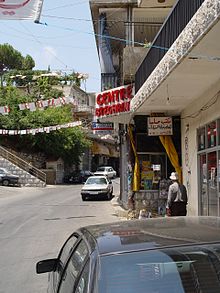 SalibaJeffrey Saliba - Trade Unionist - New England
Salibi, Saleebey and Saleeby
See also
References
External links |
||||||||||||||||

